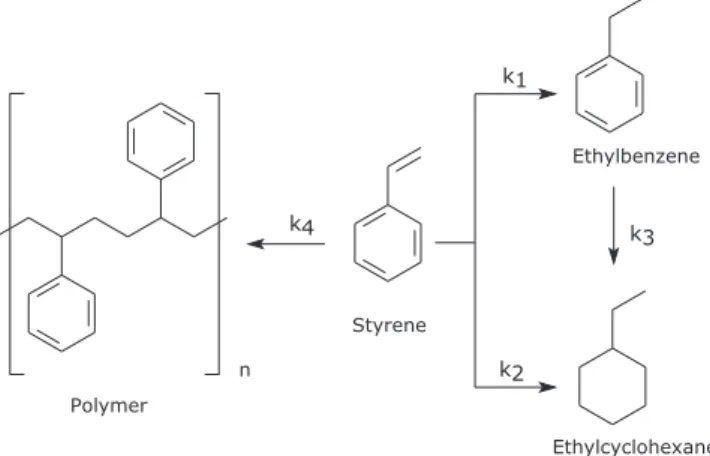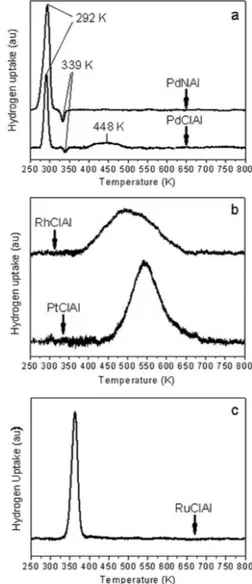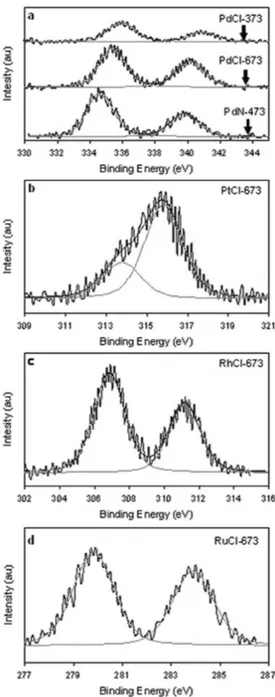Quim. Nova, Vol. 33, No. 1, 48-51, 2010
Ar
ti
go
*e-mail: jbadano@iq.unl.edu.ar
LOW METAL LOADING CATALYSTS USED FOR THE SELECTIVE HYDROGENATION OF STYRENE
Juan Badano*, Cecilia Lederhos, Mónica Quiroga y Pablo L’Argentière
Instituto de Investigaciones en Catálisis y Petroquímica, Facultad de Ingeniería Química, Universidad Nacional del Litoral, Consejo Nacional de Investigaciones Cientíicas y Técnicas, Santiago del Estero 2654, 3000 Santa Fe, Argentina
Fernando Coloma-Pascual
Servicios Técnicos de Investigación, Facultad de Ciencias, Universidad de Alicante, Apartado 99, E-03080 Alicante, Spain
Recebido em 1/12/08; aceito em 17/6/09; publicado na web em 25/11/09
A series of Group VIII metal catalysts was obtained for the semi-hydrogenation of styrene. Catalysts were characterized by Hydrogen Chemisorption, TPR and XPS. Palladium, rhodium and platinum low metal loading prepared catalysts presented high activity and selectivity (ca. 98%) during the semi-hydrogenation of styrene, being palladium the most active catalyst. The ruthenium catalyst also presented high selectivity (ca. 98%), but the lowest activity. For the palladium catalyst, the inluence of the precursor salt and of the reduction temperature on the activity and selectivity were studied. The following activity series was obtained: PdN-423 > PdCl-673 > PdCl-373> PtCl-673 > RhCl-673 >> RuCl-673. As determined by XPS, differences in activity could be attributed, at least in part, to electronic effects.
Keywords: selective hydrogenation; metal catalysts; styrene.
INTRODUCTION
In the last decade, around 35% of the gasoline consumed in USA came from cracking processes; moreover, ca. 20-40% of the gasoline consumed in the whole world was supplied by cracking processes.1,2 The petroleum cracking process generate fractions rich in benzene, toluene, xylenes (BTX), and gasoline, known as C5+ streams, with high contents in oleins, dioleines and styrene (up to 15 wt%).3-5 Due to their unstable character, dioleines and styrene should be eliminated to prevent the formation of gums in later processes or during storage.1 The catalytic hydrogenation of oleins is the most used industrial process.6,7 Styrene is a good model compound of BTX and gasoline fractions because it is one of the slower reacting components that should be removed.1 Styrene may be hydrogenated to ethylbenzene, ethylciclohexane and also could polimerize deactivating the active sites of the catalysts. In Figure 1 it can be seen the possible reaction paths.
The hydrogenation must be selective without modiication of the valuable aromatic nucleus. The group VIII metals such as Rh, Ru, Pt and Ir are well known as hydrogenation catalysts.8 Among them, the
platinum group metals catalysts allow carring out hydrogenations at milder conditions than other metals, like Ni, for industrial applications.9 Styrene hydrogenation in particular has been studied with palladium and nickel catalysts using relatively mild conditions.10,11
The continuous increase of the petroleum raw’s price and the vari-able price of Group VIII metals used as catalysts in the hydrogenation reactions, make interesting to investigate the inluence of these metals on the activity and selectivity during the selective hydrogenation of exo-cyclic double bonds C-C.
The objective of the present work is to investigate the inluence of the reduction temperature and of the precursor salt on the activity of several supported Group VIII catalysts with low metal loading, during the styrene semi-hydrogenation carried out in liquid phase.
EXPERIMENTAL
The catalysts were prepared by incipient wetness using γ-Al2O3 as support (CK-300, mesh 35-80, calcined 4 h at 823 K, 180 m2 g-1 BET surface area). To study the inluence of the metals and of the precursor salts, different acidic solutions (pH=1) were prepared. The precursors employed were: PdCl2 and Pd(NO3)2.2H2O (Fluka, Cat Nº: 76050 and 76070, respectively, purity > 99.98%), RuCl3.H2O, RhCl3.xH2O and H2PtCl6.H2O (Strem Chemicals, Cat Nº: 44-5880, 45-1880 and 78-0200, respectively, purity > 99.9%). Different acidic solutions of the choride precursor salt were prepared using HCl at pH=1. For Pd(NO3)2.2H2O an acidic solution was prepared using HNO3 at pH=1. The concentration of the solutions were calculated in order to obtain a metal loading, M/γ-Al2O3 (M = Pd, Ru, Pt, Rh), of 0.35 wt %. The γ-Al2O3 was impregnated with each solution fol-lowing the incipient wetness technique.12 The impregnated solids were dried during 24 h at 393 K, and then they were calcined under an air low during 4 h at different temperatures: Pd at 673 K and Pt, Ru and Rh at 773 K. Prior to reaction, the catalysts were reduced with H2 during 1 h at different temperatures: Pt, Ru and Rh at 673 K, Pd prepared from PdCl2 at 373 and 673 K, and Pd prepared from Pd(NO3)2 at 423 K. For the most active catalyst, the inluence of the precursor salt and of the reduction temperature were studied. The metal loading of the catalysts was obtained by spectrophotometric determinations.
Low metal loading catalysts used for the selective hydrogenation of styrene 49
Vol. 33, No. 1
The dispersion and the Temperature Programmed Reduction (TPR) determinations for each metal catalyst were determined using a Micro-meritics Auto Chem II equipment equipped with a thermal conductivity detector and cold water trap before the entering the thermal detector .
Dispersion values were obtained after reducing each sample at the above mentioned temperatures. The samples were degassed in situ for 2 h under an argon low (AGA purity 99.99%), and then cooled at room temperature except palladium catalysts, which were cooled at 373 K where the formation of palladium hydride is negligible.13 After that, the chemisorption with hydrogen was performed.
During the TPR analysis, the samples were dried in situ at 423 K for 1 h under an argon low (AGA purity 99.99%). After that, the samples were cooled up to 250 K in the same atmosphere. Then the temperature was incresed up to 1073 K at 10 K min-1 in a gas low containig 5% (v/v) hydrogen/argon, at a total low rate of 40 mL min-1.
The supericial electronic state of each metal and of chlorine and their atomic ratios were studied by X-ray Photoelectron Spectroscopy (XPS) following the Pd 3d5/2, Pt 4d5/2, Rh 3d5/2, Ru 3d5/2.and Cl 2p3/2 peaks position, respectively. As a consequence of the interference of the Al 2p line, the Pt 4d5/2 peak position was followed instead of the most common Pt 4f7/2.To correct possible deviations caused by electronic charge on the samples the Al 2p line was taken as an internal standard at 74.4 eV but also taking into account the low intense C 1s peak at 284.6 eV. Measurements were made using a VG-Microtech Multilab equipment, a MgKα (hν: 1253.6 eV) radiation and a pass energy of 50 eV. The XPS system analysis pressure was kept at 5x10-7 Pa. Samples were treated in situ with H
2 following the same procedure as that for catalyst preparation. A careful deconvolution of the spectra was made. The areas under the peaks were estimated by calculating the integral of each peak after subtracting a Shirley background and itting the experimental peak to a combination of Lorentzian/Gaussian lines of 30-70% proportions.14
The styrene selective hydrogenation was carried out in a batch PTFE coated stainless steel stirred tank reactor fed with 200 mL of a solution of 10% (v/v) styrene (Aldrich, Cat. N° S497-2, purity > 99%) in toluene (Merck, Cat. N° TX0735-44, purity > 99%), using n-decane (Fluka, Cat. N° 30550, purity > 98%) as an internal standard. The reactor was operated at 353 K, 10 bar H2 and 800 rpm. Runs were carried out in triplicate with an experimental error of 3%, using 0.2 g of catalyst and a styrene/M molar ratio equal to 2.6 104. Internal and external diffusional limitations were absent in the conditions of this work. Reactant and products were analyzed by GC equipped with a FID detector.
RESULTS AND DISCUSSION
Figure 2 shows the TPR proiles for the Pd (a), platinum and rhodium (b) and ruthenium (c) catalysts. As shown in Figure 2a, for both Pd precursor salts, a characteristic peak at 292 K was observed, corresponding to the reduction of PdO species weakly interacting with the support.15 A desorption peak at approximately 339 K was attributed to the decomposition of β-PdHx species.15,16 The catalyst prepared from PdCl2 also presented a peak at 448 K, which could be attributed to the partial reduction of Pd-chlorine-containing species, such as PdxClyOz.17 As shown in the curves depicted in Figures 2b and 2c, TPR results indicated that at 670 K Pt, Rh and Ru catalysts were reduced.
Table 1 presents the metal loading (w), metal dispersion (D), the XPS results for the metals and for chlorine and the activity results, expressed as Turn Over Frequencies (TOF) for the different catalysts. In Figure 3 are shown the XPS proiles of: palladium (a), platinum (b), rhodium (c) and ruthenium (d) catalysts. For the dispersion calculations a H/M= 1 ratio was adopted.18-21 PdCl-673, PdCl-373 and PtCl-673 presented the higher dispersion values, probably due to the formation of PdxClyOz17 and Pt
xClyOz
22 species. On the palladium and platinum
catalysts prepared from chlorine precursors (PdCl-673, PdCl-373 and PtCl-673) the XPS results showed the presence of the Cl 2p3/2 peak at ca. 198.5 eV, corresponding to supericial chloride species,23 indicating that chlorine was not completely eliminated after reduction. As shown in Figure 3, the Pd 3d5/2 peak position for PdN-423, 334.7 eV, could be assigned to Pd0.23 The Pd 3d
5/2 peak position for catalysts PdCl-673 and PdCl-373, 335.4 and 335.9 eV, respectively, could be assigned to electron-deicient species, Pdn+, with n between 0 and 2.23 It can also be seen for the last two catalysts that the hydrogen treatment temperature inluenced the amount of supericial chlorine, as the Cl/Pd atomic ratio for PdCl-373 was almost seven times higher than that for PdCl-673. For the PtCl-673 catalyst, in Figure 3b, two peaks were observed: one at 313.8 eV, assigned to Pt0, and another one at 315.8 eV, that could be assigned to electron-deicient species, Ptn+, with n between 0 and 2.23 The atomic proportions of each Pt species are also shown in Table 1. The XPS results obtained for Ru 3d5/2 and Rh 3d5/2 indicated the presence of supericial Ru0 and Rh0 species.23
Badano et al.
50 Quim. Nova
ared interesting to study the inluence of chlorine in its catalytic performance. For this reason, and only in the case of Pd, we used also a nitrate precursor.
TOF values were calculated from the conversion initial values. These results indicated the following order of activities: Pd(NO3)2 > PdCl2 > PtCl6H2 > RhCl3 >> RuCl3. The bibliography lacks of papers comparing the activity and selectivity among metals of the VIII group used as monometallic catalysts in the same operational conditions during the selective hydrogenation of high molecular mass olefinic compounds, such as styrene. For other particular reaction systems, several relative activity series can be found in the literature; as reported in the review of Hagen, these series can widely differ.24 The differences in activity between the catalysts prepared from the chloride salts could be attributed, at least in part, to differences in the electronic density of the external d orbitals of each metal: Pd, d10; Pt, d9; Rh, d8 and Ru, d7. For both palladium precursors, Pd(NO
3)2 and PdCl2, reduced at different temperatures, the following order of activities was observed: PdN-423 > PdCl-673 > PdCl-373. The differences in activity for the Pd catalysts could be attributed to the presence of Pd0 or electron-deficient species, Pdn+, on each catalyst. The higher activity (TOF value) was obtained for Pd0. It is broadly accepted in the bibliography that the electron-deficient Pdn+ species are less active as they have less d electrons available for interacting with the substrate.25
Figure 3. X�S pro� les of: palladium (a), platinum (b), rhodium (c) and ruthe-X�S pro�les of: palladium (a), platinum (b), rhodium (c) and ruthe-nium (d) catalysts
Figure 4. Styrene total conversion as a function of time for the different ca-for the different ca-talysts evaluated, (•) �dCl-673 (+) �dCl-373 () �dN-423 (◊) �tCl-673 ()
�hCl-673 () �uCl-673
Table 1. Reduction temperature (TR), metal loading (w), metal dispersion (D), metals and chlorine binding energies and Cl/M atomic supericial ratio determined by XPS and TOF for the different catalysts evaluated
Catalyst TR
(K)
w (%)
D (%)
M (eV)
Cl 2p3/2 (eV)
Cl/M (at./at.)
TOF (s-1)
PdN-423 423 0.31 26 334.7 - 0 61.9
PdCl-673 673 0.34 38 335.4 198.6 1.6 45.0
PdCl-373 373 0.34 37 335.9 198.5 10.9 41.0
PtCl-673 673 0.33 39 313.8a 198.5 2.4 27.9
315.8b
RhCl-673 673 0.32 20 306.9 - 0 23.3
RuCl-673 673 0.30 3 279.5 - 0 17.7
Low metal loading catalysts used for the selective hydrogenation of styrene 51
Vol. 33, No. 1
CONCLUSIONS
Palladium, rhodium and platinum low metal loading prepared catalysts presented high activity and selectivity (ca. 98%) during the semi-hydrogenation of styrene. The ruthenium catalyst also presented high selectivity (ca. 98%), but the lowest activity. The following activity series was obtained: PdN-423 > PdCl-673 > PdCl-373> PtCl-673 > RhCl-673 >> RuCl-673. Differences in activity could be attributed, at least in part, to electronic effects.
ACKNOWLEDGEMENTS
The experimental assistance of C. Mázzaro and the i nancial as-Mázzaro and the i nancial as- and the inancial as-sistance of CONICET, ANPCyT and UNL are greatly acknowledged.
REFERENCES
1. Nijhuis, T. A.; Dautzenberg, F. M.; Moulijn, J. A.: Chem. Eng. Sci.2003,
58, 1113.
2. Choi, J. S.; Maugé, F.; Pichon, C.; Fourcade, J. O.; Jumas, J. C.; Clair, C. P.; Uzio, D.; Appl. Catal., A2004, 267, 203.
3. Hatch, L. F.; Matar, S.; From Hydrocarbon to �etrochemicals, Gulf Publishing Company: Houston, 1981, chap. 3 and 7.
4. Chauvel, G.; Lefebvre, G.; �etrochemical �rocesses, Institut Francais du Pétrole Publictions : Paris, 1989, chap. 2.
5. Sadeghbeigi, R.; Fluid Catalytic Cracking Handbook, Gulf Publishing Company: Houston, 2000, chap. 1 and 10.
6. Cheng, Y. M.; Chang, J. R; Wu, J. C; Appl. Catal., A1986, 24, 273. 7. Derrien, M.L. In Catalytic Hydrogenation, Červený, L., Ed.; Elsevier
Publishers: Amsterdam, 1986, vol. 27, p. 652.
8. Bernas, A.; Kumar, N.; Maki-Arvela, P.; Kul’kova, N. V.; Holmbom, B.; Salmi, T.; Yu, D.; Murzin, D.Y.; Appl. Catal., A2003, 245, 257.
9. Ray, J. D.; J. Am. Oil Chem. Soc. 1985, 62, 1213.
10. Hoffer, B. W.; Bonné, R. L. C.; van Langeveld, A. D.; Grifiths, C.; Lok, C. M.; Moulijn, J. A.; Fuel2004, 83, 1.
11. Damyanova, S.; Daza, L.; Fierro, J. L. G.; J. Catal.1996, 159, 150. 12. Seoane, X. L.; L’Argentière, P. C.; Fígoli, N. S.; Arcoya, A.; Catal. Lett.
1992, 16, 137.
13. Boudart, M.; Hwang, H. S.; J. Catal.1975, 39, 44.
14. Lederhos, C. R.; L’Argentière, P. C.; Coloma-Pascual, F.; Fígoli, N. S.;
Catal. Lett.2006, 110, 23.
15. Gaspar, A. B.; Rosa dos Santos, G.; de Souza Costa, R.; Pereira da Silva, M. A.; Catal. �oday 2008, 133, 400.
16. Shen, W.-J.; Okumura, M.; Matsumura, Y.; Haruta, M.; Appl. Catal., A 2001, 213, 225.
17. Gaspar, A. B.; Dieguez, L. C.; Appl. Catal., A2001, 201, 241. 18. Reyes, P.; Pecchi, G.; Morales, M.; Fierro, J. L. G.; Appl. Catal., A1997,
163, 145.
19. Mazzieri, V.; Coloma-Pascual, F.; Arcoya, A.; L’Argentière, P. C.; Fígoli, N. S.; Appl. Surf. Sci.2003, 210, 222.
20. Sermon, P. A.; J. Catal.1972, 24, 460.
21. Li, J.-M.; Huang, F.-Y.; Weng, W.-Z.; Pei, X.-Q.; Luo, C.-R.; Lin, H.-Q.; Huang, C.-J.; Wan H.-L.; Catal. �oday2008, 131, 179.
22. Lieske, H.; Lietz, G.; Spindler, H.; Völter, J.; J. Catal.1983, 8, 81. 23. NIS� X-ray �hotoelectron Spectroscopy Database NIS� Standard
�eference Database 20, Version 3.5 (Web Version), National Institute
of Standards and Technology, USA, 2007.
24. Hagen, J.; Industrial Catalysis, A �ractical Approach, Wiley-VCH Verlag GmbH & Co. KgaA: Weinheim, 2nd ed., 2006, p. 150.


